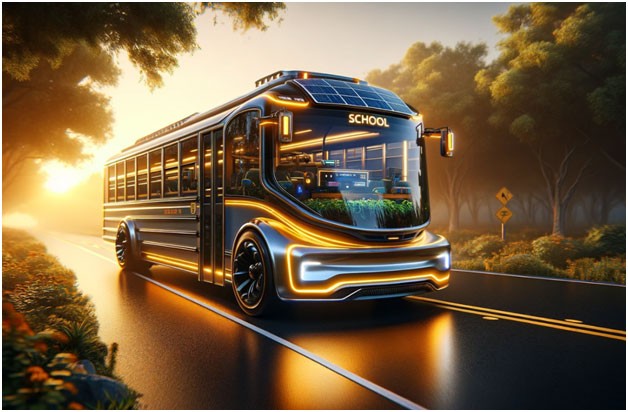
Image via Dall-E
Since the inception of school buses in the late 19th century, these iconic yellow vehicles have been a cornerstone of safe and reliable student transportation.
The storied history of the school bus is one pitted with both potholes and, too, amazing periods of advancement and inclusion. Starting with horse-drawn carriages in the mid-to-late 1800s, for decades children were transported on rickety rides to their one-room schoolhouses. As more and more states began to adopt mandatory education laws for youngsters, the search was on for providing reliable transportation for these learners.
Early motorized vehicles - often customized contraptions - did their best to meet the specific needs of carrying students. But safety features and comfort usually took a back seat.
By the 1930s, pioneers like Frank Cyr, a long-serving schoolteacher, championed the advancement of bus innovations like the ubiquitous glossy yellow color and standardized safety practices. Fast forward to today where modern motorized fleets trundle down the roads with significant transformations.
As we step into the future, technological advancements are poised to revolutionize the way we think about school bus transportation, ensuring not only safety but also enhanced learning experiences for students.
Let’s look at the importance of innovation in shaping the future of school buses in the areas of safety, accessibility, and fostering a learning environment. In doing so, we may glimpse some of the changes coming on the horizon.
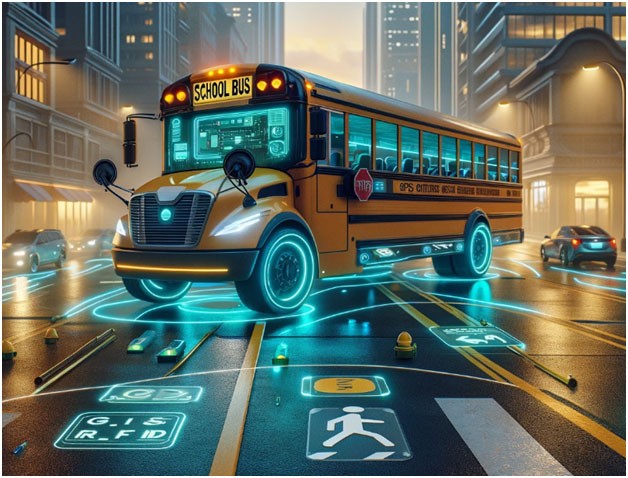
Image via Dall-E
The Future of Safety in School Buses
Advanced Safety Features
Safety has long been paramount in school bus transportation. The future holds even greater promise with cutting-edge technologies. By looking at the consumer vehicle market, we spy some of the advancements that are sure to appear on yellow school buses around the country.
Collision avoidance systems, automatic braking, and blind spot detection are among the innovations set to redefine safety standards. These systems leverage an interconnected series of sensors, cameras, and sophisticated algorithms that form part of the burgeoning Internet-of-Things (IoT) market.
These manifold devices hold the promise of detecting potential hazards and assisting drivers in making split-second decisions to prevent accidents and increase fleet performance.
Another innovation just beginning to influence the vehicle market is artificial intelligence (AI). These intelligent systems can diagnose and predict when maintenance will be required and lead to proactive rather than reactive maintenance.
By integrating these technologies into school buses and operations procedures, we can significantly reduce the risk of collisions, protect precious young lives on the road, and cut maintenance costs for school systems.
Enhanced Monitoring and Tracking Systems
Tracking and monitoring fleet vehicles and students enhances the overall security of a school district’s transportation system. Two technologies that are at the forefront of this security push are GPS and RFID.
GPS, or Global Positioning System, is a US-owned service that is supported by a network of satellites to determine accurate locations of things. Some GPS receivers are so sensitive that they can pinpoint the latitude, longitude, and altitude of an object to less than an inch!
With receivers attached to buses and other school-owned passenger vehicles, real-time tracking can keep things running smoothly and allow for better response during an emergency.
Radio-frequency identification (RFID) relies on small tags that transmit data via radio signal to a radio receiver. Think of a badge card held by each bus rider that they scan every time they enter and exit a bus. This can provide location tracking for staff and parents and provide peace of mind – avoiding tragedies like that of a sleeping child being accidentally locked on a bus.
A trial study by a team of researchers in Qatar found that an RFID-enabled tracking system received a 95% favorable rating from parents who saw less anxiety and worry about their children when they could track their location.
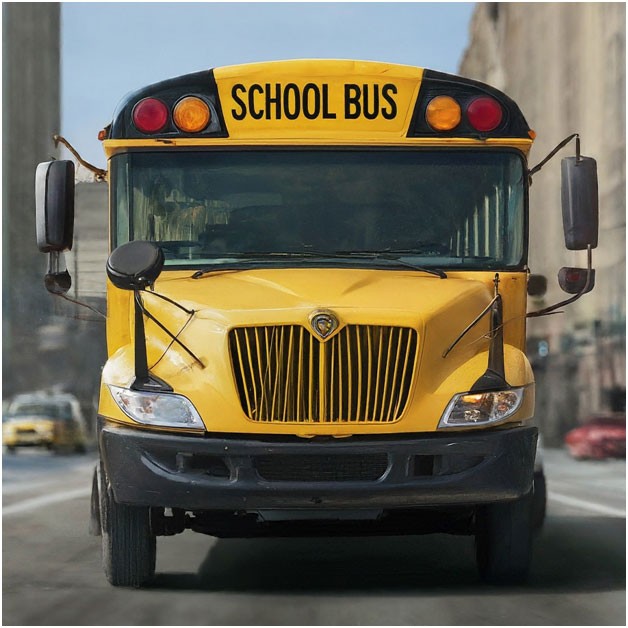
Image via Gemini
Safety Through Design
Innovative design elements are key to enhancing safety on school buses. Major automotive manufacturers spend countless dollars and hours finding the perfect amalgamation of form and function to create sleep masterpieces.
While the basic structure of school buses has changed little over the last 50 years, design elements have improved and continue to provide a more streamlined and comfortable ride for drivers and passengers alike.
Ergonomic seating ensures that students are comfortably seated during their journey, reducing fatigue, and minimizing the risk of injuries in the event of sudden stops or accidents.
Improved driver visibility is another critical aspect of safety-oriented design. Advanced panoramic windows and strategically positioned mirrors provide drivers with a comprehensive view of their surroundings, enabling them to navigate traffic with greater confidence and precision. Some buses are beginning to be equipped with 360-degree camera systems so that every angle around the bus is viewable for the driver at bus stops.
Integrated seatbelts further reinforce safety measures, ensuring that students remain securely strapped throughout their journey.
Inclusive Design Principles
The reality is that one-size-fits-all is rarely true. Many districts need customizations to accommodate the needs of their students. Disability features like motorized ramps and wheelchair lifts assist students with entering and exiting the bus.
Some vehicles come equipped with air-powered lift systems that lower the entire vehicle to ground level to make it easier to step on and off the bus. Automatic doors with wider openings can also make it easier to board and disembark.
School districts have found that when they think through these up-and-coming design features, they can plan when making new purchases and avoid costly customizations later.
Smart Solutions for Urban and Rural Accessibility
Just as every student is different, so every school system is different. They will face their own challenges based on their diverse environments, both rural and urban. What are some strategies that districts can use to address their unique needs?
Advanced software can assist transportation directors with the monumental task of creating efficient routes that provide safe and timely pick-up and drop-off. In some cases, this software can point out where changes can be made to improve or eliminate unnecessary routes.
Some questions that the right data can answer:
- Are certain routes only needed on specific days or at certain times?
- Could moving a designated drop-off zone allow for greater accessibility?
- Should school start times be staggered to allow for fewer vehicles and bus runs?
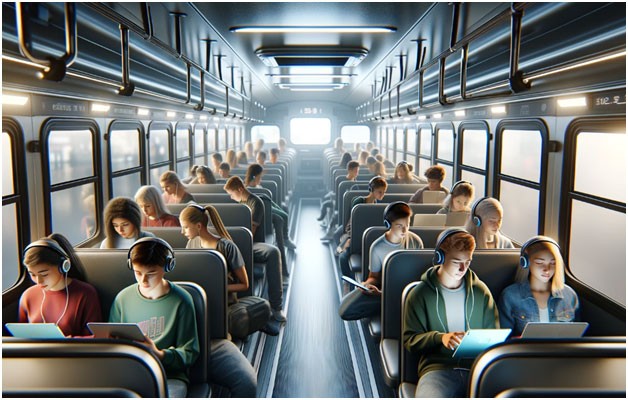
Image via Dall-E
Personalized Learning Environments on the Move
Many districts accept the reality that the school bus has become an extension of the classroom, fostering learning opportunities even during transit. Integrated technology is making this vision a reality, transforming traditional buses into dynamic learning environments.
Interactive displays, Wi-Fi connectivity, and onboard computers enable students to engage in educational activities, access digital resources, and collaborate with their peers while on the move.
Educational apps and multimedia content cater to diverse learning styles, enriching the educational experience and maximizing instructional time. Moreover, these technologies facilitate seamless communication between students and educators, enabling real-time feedback and personalized learning experiences tailored to individual needs.
In one case study in Beekmantown Central School District in upstate New York, the district found that equipping their school buses with Wi-Fi hotspots led to a tangible benefit – an accompanying 50% drop in behavior issues.
The Role of Customization
The future promise of even greater customization is becoming a more plausible solution as we see greater advancement in Virtual Reality (VR) and Augmented Reality (AR) in education. These technologies could potentially offer immersive learning experienceson the go so that every student has a customized learning plan that extends outward from the traditional classroom.
These dreams of a better education are not without their challenges. In some locales, limited internet access will reduce the effectiveness of bus-centric education time. Downloadable offline content is one avenue of addressing this situation.
Another potential problem is the distraction of other learners in the close quarters of the school bus. Designated quiet zones can be implemented to reduce annoyances while supporting ongoing education initiatives in these mobile classrooms.
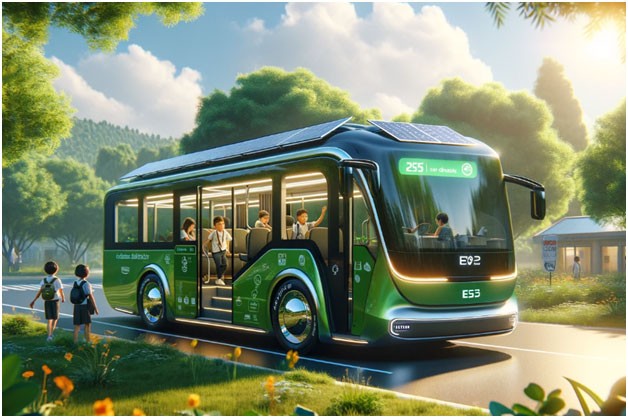
Image via Dall-E
Sustainable and Eco-Friendly Innovations
Electric and hybrid buses offer significant benefits to education systems in reducing emissions and their environmental impact compared to traditional diesel buses. Look at just a few of the benefits that can be realized by making the jump to more sustainable technologies versus traditional diesel buses.
Pollution Reduction
Electric buses produce zero tailpipe emissions, reducing harmful pollutants such as nitrogen oxides, particulates, and carbon dioxide emissions.
Hybrid buses also produce fewer emissions than conventional diesel buses because they utilize a combination of electric and diesel power, allowing for improved fuel efficiency and lower emissions.
Another consideration is the noise pollution that traditional buses produce. Electric buses are quieter than diesel buses, contributing to a reduction in the overwhelming noise in urban areas. This can lead to an improved quality of life for residents and decreased stress for passengers and drivers.
Energy Efficiency
Electric buses are more energy-efficient than diesel buses because electric motors are inherently more efficient than internal combustion engines. Regenerative braking systems in electric buses capture energy during braking and convert it back into electricity, further improving efficiency.
Electric buses can be powered by renewable energy sources such as solar, wind, or hydroelectric power, further reducing their environmental impact. Solar power integration for auxiliary systems, such as heating, ventilation, and air conditioningsystems, can reduce the overall energy consumption of the bus and contribute to its long-term sustainability.
Reduced Operating Costs
While electric buses may have higher upfront costs compared to diesel buses, they typically have lower operating costs over their lifespan. Electric buses have fewer moving parts and require less maintenance than diesel buses, resulting in lower maintenance and fuel costs.
Health Benefits
By reducing air pollution, electric and hybrid buses can help improve public health outcomes by lowering rates of respiratory illnesses and cardiovascular diseases associated with air pollution exposure.
Educational Opportunities
Adopting green technologies for school bus fleets provides educational opportunities for students to learn about sustainability, renewable energy, and environmental stewardship.
Schools can incorporate these topics into their curriculum and engage students in hands-on learning experiences related to clean transportation technologies.
Community Engagement
Transitioning to green school buses can foster community engagement and support for sustainability initiatives within the school district and the broader community. Schools can involve parents, students, teachers, and local stakeholders in the decision-making process and raise awareness about the environmental and economic benefits of green transportation.
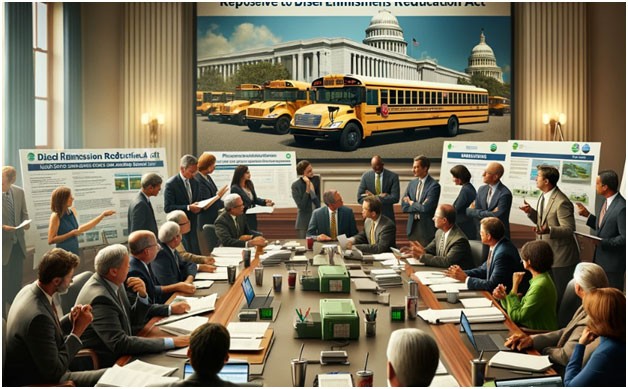
Image vis Dall-E
Financing and Implementing New Technologies
For many school districts, financial realities must be the major factor in the decision to implement new technologies like transforming their bus fleets.
The federal government often provides grants to support the adoption of clean energy technologies, including electric and alternative fuel vehicles. For example, the U.S. Environmental Protection Agency (EPA) offers grants through programs like the Diesel Emissions Reduction Act (DERA) and the Clean School Bus program, which provide funding for replacing older diesel buses with cleaner alternatives.
Many states and local governments offer grants and incentives to encourage the adoption of environmentally friendly transportation solutions, such as electric and hybrid buses. Grants may be administered by state environmental agencies, departments of transportation, or energy offices.Some electric utilities offer incentives or rebates to schools and other organizations for purchasing electric vehicles or installing charging infrastructure.
School districts can use bond financing to fund capital investments in new buses and infrastructure. Bonds allow districts to spread the cost of purchasing new buses over time, making it easier to manage upfront costs while realizing long-term savings on fuel and maintenance.
When considering the return on investment (ROI) concept for innovative school buses, it's essential to balance the upfront costs of new technologies with the long-term savings on fuel, maintenance, and overall efficiency. A careful and thorough analysis can provide insights into the overall sustainability, cost-effectiveness, and risk of adopting new technologies.
(Bus) Riding into the Future
We’ve come a long way from the horse-drawn carriages of yesteryear. Twenty-six million studentboard yellow school buses in the US each day and arrive safe and sound at their halls of learning.
The design and technology solutions on the horizon for buses will continue to shape the student experience and provide more and better standards of safety and inclusion.
School districts must engage with their stakeholders, including educators, policymakers, parents, and community leaders. Wise decisions on bus innovations become an opportunity for collaboration and an impetus for cooperation.
Explore more innovative transportation solutions that have already begun to change the bus industry for the better. In doing so, you’ll gain a greater appreciation for the gentle, yellow behemoth we know and love – the school bus.
References
https://www.smithsonianmag.com/innovation/history-school-bus-180980554
https://builtin.com/internet-things/iot-in-vehicles
https://stnonline.com/special-reports/are-students-using-school-bus-wi-fi



